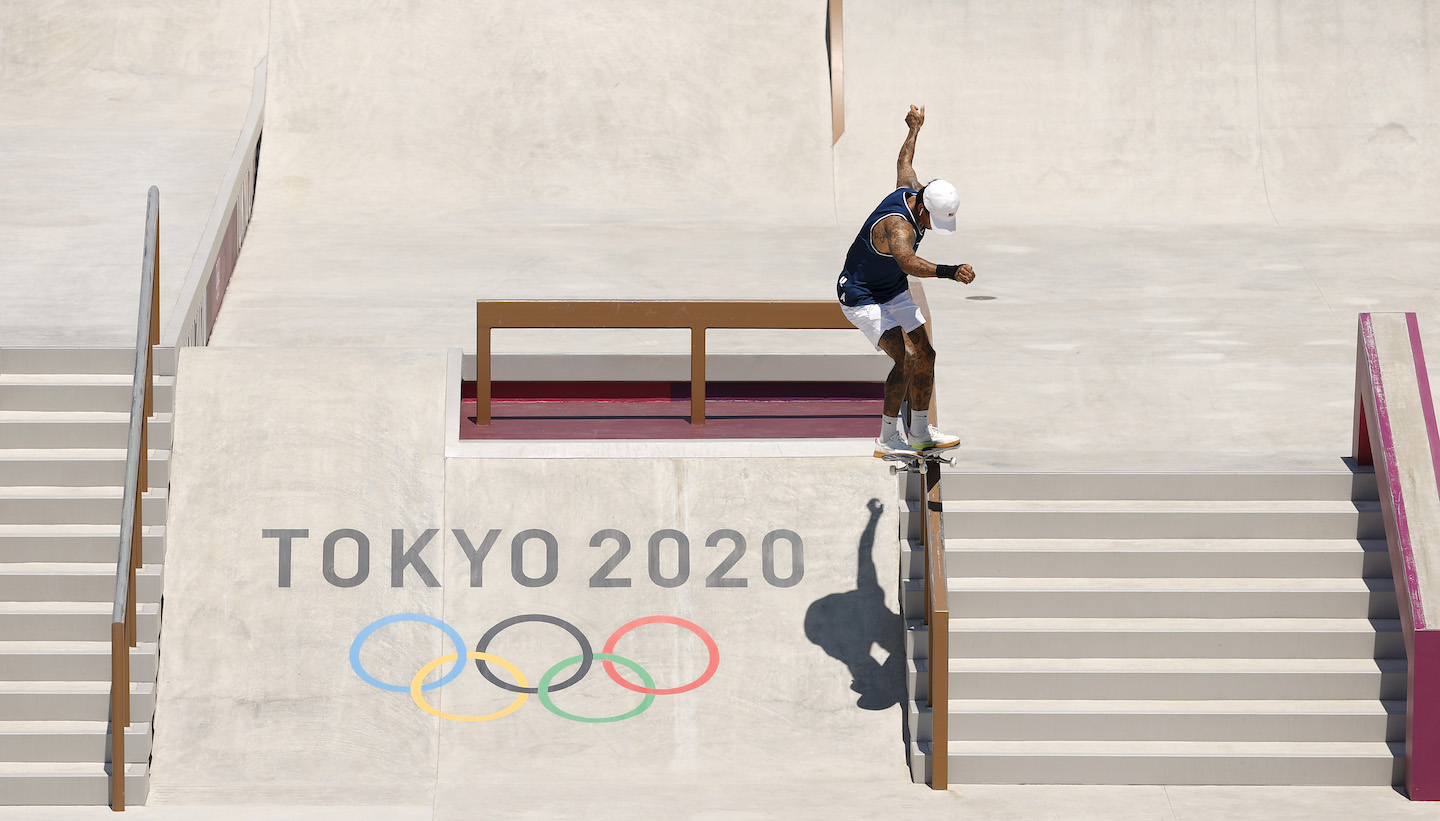Skaters are generally anti-rules, anti-structure, anti-regulation, anti-anything that encroaches on the freedom and expression of skate culture, so at first there was resistance in the skating community about IOC's interest in skating, to the point where petitions circulated urging a big fat NO to skateboarding in the Olympics. Sometimes it feels like the IOC exists solely to discourage athlete individuality and over-regulate a sport, and skaters typically don’t even wear uniforms in competition, or even bibs with numbers. They wear pants or shorts, whatever the hell t-shirt they want to, and some even compete with headphones in.
"I know a lot of skaters are worried that skateboarding will be misrepresented in the Olympics," said Paul Zitzer, skateboarding analyst for NBC and a former pro skater himself. “But I have confidence that it won’t be. Because the skaters who have qualified to skate here, they are skaters, they live and breathe to skate. The people who are judging are former pro skaters. The people talking about it—Tony Hawk is here, he is going to be talking about skating, I am a skater, a pro skater in the '90s—I am going to be doing everything I can to represent skating in the most authentic way. I hope people who don’t skate can see how cool skateboarding is and that people who do skate can feel good about the way skateboarding was represented here for the first time. Hopefully they feel like skateboarding is still in good hands even though every last aspect of it isn't necessarily run by skaters."
Most sports have to campaign for their Olympic inclusion, but not skateboarding. "Skaters weren’t trying to get skateboarding in the Olympics," Zitzer told me. "It was the other way around, the Olympics wanted skateboarding."
How it works: There are two disciplines, park and street, with medals available in each for men and women. There aren’t any skaters who qualified for both events, so there are 80 athletes competing, 20 per discipline per gender.
Park is similar to the half-pipe in snowboarding, where athletes show off their best tricks while skating in a bowl, and it originated from skaters who experimented with skating in empty swimming pools in the 1970s. Skaters take three 45-second runs on the bowl, and their best score of the three is the only score that counts, encouraging them to go big and not play it safe.
Every bowl is set up differently. “There is no regulation size, there is no out of bounds, anything goes,” Zitzer said. “It would be kind of anti-skateboarding to build any standardized type park. Skaters would not think that’s cool. Part of what is awesome about the park skaters is their ability to show up and adapt to anything."
There are four different types of tricks in park.
Airs: A skater leaves the ground with his board underneath him. “There’s a million different ways to do an air,” said Zitzer. “Where you grab your board, which direction you turn or how many degrees you spin.”
Handplants: When a skater goes upside down and the board is one hand and the other hand is on the coping, the cement lip on the top of the park.
Grinds: When a skater comes up to the coping and grinds their trucks, the metal pieces mounted underneath the board to keep the wheels in place.
Slides: When a skater slides along the edge with part of the skateboard, not the trucks.
Skating is not like gymnastics, with a code of points and a certain difficulty score assigned to each trick (there aren't even limitations or specifications on the size, shape or type of skateboard, and most skaters never even had coaches before skateboarding was announced as an Olympic sport—and many still don't). Park skaters are scored on a scale of 100 by a panel of judges who are looking for skaters to show they can skate the whole bowl, progressive moves, and speed in skating. Big tricks will always score well, but there’s no standard value.
“That’s because if you attach those numbers to the tricks, it tends to dictate what people end up doing at the next event,” Zitzer said. “They know this trick will get that score and people will show up and do those tricks next time. That's another thing skaters resist. Skating is about progression, new things, the envelope being pushed.”
Street is a course that resembles what a skater might find “in the wild,” as Zitzer put it. Benches, stairs, hand railings, curbs, banks, etc. The scoring format is trickier. Skaters take two 45-second runs and then get five attempts at individual tricks, but only the top four scores count and those are added together for the final score. Most skaters won’t land all five of their trick attempts, and they don’t need to. They just need two good tricks landed. And there are other times where “people have meltdowns and don't make a single trick,” Zitzer said.
“In the street it's more flip tricks, where the board is flipping under your feet. And then there’s going to be a lot of rail tricks where people are either sliding or grinding just like they do on the park but instead of on the coping, they do it on the hand rails.”
There’s no age minimum. 12-year-old Kokona Hiraki and 13-year-old Sky Brown are among the favorites for the women’s park competition, they are ranked No. 6 and No. 3 in the world respectively. I’ll tell you more about Brown later because she is probably the coolest athlete in this entire Olympiad and I think I might die for her. “They talked about an age limit,” Zitzer said. “But in some ways, being smaller and younger is a benefit and in other ways, it can hurt your chances of doing well because the younger skaters typically don’t have as much power behind their skating so they struggle with speed and air time.”
The 540 is a game-changer for women. 15-year-old Japanese skater Misugu Okamoto is the first woman to consistently land 540s in competition, starting about three years ago. Before that, 540s weren’t really seen much in women’s park. Now, Zitner says, a handful of women have 540s in their arsenal (including my girl Sky Brown). “So that is going to be a huge trick," Zitzer said. "If they are all skating at a similar level and one or two are able to put a 540 in the run, that could be the determining factor.”
Some other helpful skater words to know…
Spine: A part of some park courses where two transitions butt up against each other and come up into a point.
Escalator: Another part of the park, where the bowl is different heights and the escalator takes you down from the deeper part to the shallow part, or takes you up, depending on which direction you skate.
Boned it: When a skater is in the air and they push the board out in front with their front leg and point it downwards.
Wall jam: In park, when a skater launches out of the bowl to a wall, sticks the board to the wall and then grabs the board and yanks it bank, dropping back into the bowl. “It is easy to fly out of the bowl," Zitzer said. "Getting back in is the really hard part.”
Switch stance: Skaters have a dominant foot. When skaters get really advanced, they can double their trick selection by learning all their tricks switch stance, with their non-dominant foot forward, and judges recognize that added difficulty. “It is not just twice as hard, it is exponentially more difficult to learn your tricks switch stance,” Zitzer said.
Why this sport rules: There’s a chance we could see some never-been-done-before moves in Tokyo. All of the basic skating tricks were created in the ‘80s and ‘90s and many are named after their creators (Ollie, Caballerial, McTwist etc.) so the new moves now are combinations of tricks in seemingly impossible sequence. Zitzer said Japanese men’s street skater Yuto Horigome, No. 2 in the world, is the athlete most likely to whip out a new trick. He specializes in nollies (popping off the nose, the front of the board rather than the tail for the ollie) and spinning onto rails blind. “It requires such precise aim, and a weird sense of fearlessness, to trust that when he comes around and puts his board on it to grind or slide down it, that the rail is going to be right there,” Zitzer said. “It is beyond comprehension.”
Zitzer said he’s dubbed one of Yuto’s tricks the “Yuto grind” because it’s easier than saying the full name of the trick sequence, which is so long I am confident I did not write it down properly while taking notes. But here's what I have: A nollie frontside 180 to switch stance backside grind to 180 out down the handrail. I'm sorry, what?!
American street skater Nyjah Huston is No. 1 in the world and the favorite for gold in men’s street. Zitzer said Huston could also bring something new to this competition, and he and Horigome will be battling to be the most innovative.
“The styles,” Zitzer said, are "one of the coolest things about skateboarding, there is an unlimited way of approaching the park and the street. There are no rules in terms of how you should skate.”
Athletes you will become obsessed with:
SKY. BROWN. I am so excited to introduce you to Sky Brown, a 13-year-old skater who was born in Japan and lives in California, but will be representing Great Britain in this Olympics because her dad is British. Brown is an absolutely insane skater. She can do 540s in her sleep! She just won her first X Games gold last weekend with these brilliant airs:
She does some truly terrifying stunts without fear, like the time last summer that she skated Elliot Sloan's “mega ramp” or as I like to call it, a totally irresponsible death drop, just a few months after going through a traumatic skating accident.
Because video culture is big in skating and Sky is active on social media, of course someone was filming her just before her big fall. Sky was practicing on a very tall vert ramp last May when she zoomed right off the corner edge and fell 15 feet onto concrete. Thankfully, the person filming did not capture her actual fall because they were running to her aid. Watch at your own risk:
Sky was medevac'd to the hospital. Her dad posted to Instagram a few days after her accident with more awful details.
“I held her in my arms and she bled helplessly moaning in and out of consciousness waiting for the helicopter to take her to the hospital. We spent the night sick and terrified not knowing if Sky was going to make it through the night, as the ICU team tried to get her conscious and kept her alive. We prayed and begged God to give Sky another chance. Word came back while she was still unconscious, multiple fractures to her skull, a broken left arm, which she broke into pieces because she used it to break her fall, broken right fingers and lacerations to her heart and lungs.”
And less than two months later, she was back in the bowl doing whatever the heck this is!
Also, I blame Tony Hawk for her accident because just weeks earlier, she posted on Instagram that Hawk had encouraged her to try to jump across the channel between the two big vert ramps. Dangerous influence!
Sky is also a very good surfer, naturally, and she won Dancing With The Stars: Juniors in 2018. Because skating and surfing just didn’t keep her busy enough.
Just look at teeny Sky!
When to watch: Skating action begins Saturday, with the first heat of men's street at 7:30 p.m. EDT, and the final at 11:25 p.m. EDT. Women's street starts is Sunday at 7:30 p.m. EDT. Women's park is Aug. 4 and men's park is Aug. 5.





